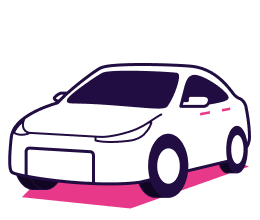Does Car Insurance Cover a Hit-And-Run?
 Editorial Standards
Editorial Standards SmartFinancial Offers Unbiased, Fact-based Information. Our fact-checked articles are intended to educate insurance shoppers so they can make the right buying decisions. Learn More
Your auto insurer may cover losses from a hit-and-run accident depending on what coverages you have in your policy. Bodily injuries and property damage expenses may be covered under the following coverage types: collision, uninsured/underinsured motorist, personal injury protection or medical payments. Not all states require you to carry these coverages, so you may need to add them to your policy at an additional cost.
Keep reading to see when each type of coverage applies following a hit-and-run accident.
How Does Insurance Cover a Hit-And-Run Accident?
You may be covered in hit-and-run accidents under the collision, medical payments, personal injury protection or uninsured motorist coverages in your auto insurance policy. Not all of these coverages are not state-mandated, and you may need to buy additional coverage to be reimbursed for certain losses.
|
Coverage |
Required by Law? |
Can I File a Claim? |
|---|---|---|
|
Collision |
No |
Yes, for property damage-related losses |
|
Medical payments/Personal injury protection |
Some states |
Yes, for bodily injuries-related losses |
|
Uninsured/underinsured motorist |
Some states |
Sometimes, for property damage/bodily injuries-related losses |
|
Liability (other driver's policy) |
Most states |
Yes, for property damage/bodily injuries-related losses (applies only if you identify the other driver) |
|
Comprehensive |
No |
No |
Collision
Collision coverage pays for repair expenses up to the coverage limits if your car was damaged following a hit-and-run. Since collision coverage kicks in regardless of who caused the accident, you would not need to identify the driver who fled the scene before your insurer covers your losses, which may be difficult to do.
Medical Payments
Medical expenses related to injuries sustained during the hit-and-run are covered under medical payments (Medpay) coverage up to your coverage limits. Eligible expenses under Medpay coverage include: x-rays, doctor bills, nursing services and health insurance deductibles and copays. Deductibles — the out-of-pocket cost before your insurance kicks in — are typically not required with Medpay coverage.
Personal Injury Protection
Similar to Medpay coverage, personal injury protection (PIP) pays for medical expenses up to your policy limits for injuries related to the hit-and-run, such as x-rays and doctor bills. PIP coverage may also cover funeral expenses or lost wages if you're unable to return to work due to your injuries. Deductibles are sometimes required.
PIP coverage is available and sometimes required in states with no-fault insurance laws. In states without PIP coverage, drivers can buy Medpay to receive coverage for car accident-related bodily injuries.
Uninsured/Underinsured Motorist
Uninsured motorist coverage may cover your losses up to your policy limits whether or not you can identify the driver who hit you. If you identify the driver and they do have car insurance but have insufficient coverage to fully cover your losses, then underinsured motorist coverage would cover the difference.
Uninsured/underinsured motorist coverage has two different types of coverage: bodily injuries and property damages. Uninsured motorist property damage coverage would pay for repairs to your car while uninsured motorist bodily injury coverage would pay for medical expenses. A deductible would typically apply for a property damage claim, but not a bodily injury claim.
Whether this coverage would apply depends on your policy and insurer. Generally, collision coverage would be necessary for covering property damage losses if you cannot identify the driver, while Medpay/PIP coverage would cover your medical expenses.
Liability (other driver's policy)
If you are able to identify the driver who fled the hit-and-run scene, you can file a hit-and-run claim with the other driver's insurance company to cover your losses. Repair bills would be covered under the other driver's property damage liability coverage and medical bills would be covered under their bodily injury liability coverage.
Virtually every state requires drivers to have liability insurance, so your chances of getting reimbursed is quite high but only if you can track down the at-fault driver. The chances are lower if the driver hit your parked car and you were not present when the incident happened. If the other driver does not have car insurance or not enough coverage, then your uninsured/underinsured motorist coverage would apply.
What Should You Do if You're in a Hit-And-Run?
Seeing the driver who hit you speed away out of sight can be disheartening on top of the post-collision shock. The steps below can help you ensure your safety and sort out the claims process.
-
Pull over and assess the situation: After the hit-and-run, check if you or your passengers are injured. As soon as it is safe to do so, turn on your hazard lights and pull over to the side of the road.
-
Call the police: It's best to call the police immediately and inform them that you were the victim of a hit-and-run. The phone operator will walk you through on what you should do next.
-
Take notes on the accident: Write down information about the fleeing vehicle, including make, model and color and the passenger's appearance. Take photos of damages to your vehicle, injuries sustained during the collision and the accident scene. Talk to witnesses, if any, and ask them for their name and contact information.
-
Notify your insurance company: Contact your insurance agent to file a car insurance claim. Your insurer will request details about the hit-and-run and may ask for you to provide them with the police report, photographs and the witnesses' contact information. Your insurer will explain how your coverages work and next steps for getting reimbursed for your loss, if your claim is approved.
How Do Claims for Hit-And-Run Accidents Work?
Auto insurance typically covers two categories of losses: property damage and bodily injury. Property damages are covered under collision and uninsured motorist property damage coverage. Bodily injuries are covered under Medpay and PIP coverage. In some cases, your uninsured/underinsured may provide coverage for property damage or bodily injuries.
Not all drivers will have all of the above coverages but some of them are required in select states. Collision coverage is never a state-mandated coverage.
If you're filing a property damage claim, you may need to pay a deductible. This is out-of-pocket cost before your car insurance coverage kicks in. If your repair bills are $1,200 and you have a $500 deductible, then you will pay $500 out-of-pocket and your insurance company will cover the remaining $700. Bodily injury insurance claims under your Medpay/PIP coverage typically do not have a deductible but this may vary by the insurer.
Will a Hit-And-Run Raise My Insurance Cost?
Your car insurance premium typically will not increase after filing an insurance claim for a hit-and-run because you were not at fault. However, increased claim frequency can. If you're filing multiple car insurance claims within a short period — even if you are not at fault — then you may see your insurance rates rise.
If you commit a hit-and-run and you're caught, your insurance rates will increase.
What Are the Consequences of Committing a Hit-And-Run?
Committing a hit-and-run is illegal and may be considered a misdemeanor or felony in some states, depending on the severity of the accident. If you were the responsible party for injuries to the other driver in a car accident and fled the scene, you will likely face more severe consequences. Consequences for committing a hit-and-run include:
-
Paying fines
-
Imprisonment
-
Suspension of your driver's license
-
FilING and maintaining form SR-22 for a certain period
If you are involved in a car accident, you must stop. Take the correct steps by pulling to the side of the road and calling 911 immediately if you discover somebody is injured.
Make Sure You're Covered in Case a Hit-and-Run Driver Flees
Accidents can be traumatic, and you may be slapped with the full cost of repair and medical bills if a driver flees the scene and you don't have the right car insurance coverage. Collision coverage ensures your property damages are covered when the other driver flees, while Medpay/PIP coverage pays for your medical bills.
SmartFinancial makes it easy to customize coverages at a rate that works for you. Just answer a few questions after entering your zip code below to receive your free car insurance quotes.
- Insurance quotes /
- Auto /
- Hit And Run Accident






